Updated Two-Port Networks MCQs ( Network Theory ) MCQs – Most Latest Network Theory MCQs
Latest Network Theory MCQs
By practicing these MCQs of Two-Port Networks MCQs ( Network Theory ) MCQs – Latest Competitive MCQs , an individual for exams performs better than before. This post comprising of objective questions and answers related to “ Two-Port Networks MCQs ( Network Theory ) Mcqs “. As wise people believe “Perfect Practice make a Man Perfect”. It is therefore practice these mcqs of Network Theory to approach the success. Tab this page to check ” Two-Port Networks MCQs ( Network Theory )” for the preparation of competitive mcqs, FPSC mcqs, PPSC mcqs, SPSC mcqs, KPPSC mcqs, AJKPSC mcqs, BPSC mcqs, NTS mcqs, PTS mcqs, OTS mcqs, Atomic Energy mcqs, Pak Army mcqs, Pak Navy mcqs, CTS mcqs, ETEA mcqs and others.
Network Theory MCQs – Two-Port Networks MCQs ( Network Theory ) MCQs
The most occurred mcqs of Two-Port Networks MCQs ( Network Theory ) in past papers. Past papers of Two-Port Networks MCQs ( Network Theory ) Mcqs. Past papers of Two-Port Networks MCQs ( Network Theory ) Mcqs . Mcqs are the necessary part of any competitive / job related exams. The Mcqs having specific numbers in any written test. It is therefore everyone have to learn / remember the related Two-Port Networks MCQs ( Network Theory ) Mcqs. The Important series of Two-Port Networks MCQs ( Network Theory ) Mcqs are given below:
Series-Series Connection of Two Port Network
1. In the circuit given below, the value of R is ___________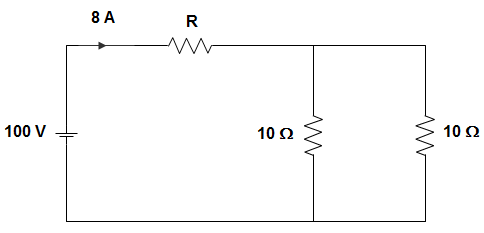
a) 2.5 Ω
b) 5.0 Ω
c) 7.5 Ω
d) 10.0 Ω
Answer: c
Explanation: The resultant R when viewed from voltage source = 1008 = 12.5
∴ R = 12.5 – 10 || 10 = 12.5 – 5 = 7.55 Ω.
2. In the circuit given below, the number of chords in the graph is ________________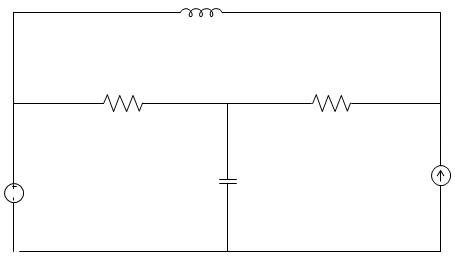
a) 3
b) 4
c) 5
d) 6
Answer: b
Explanation: Given that, b = 6, n = 3
Number of Links is given by, b – n + 1
= 6 – 3 + 1 = 4.
3. In the circuit given below, the current through the 2 kΩ resistance is _____________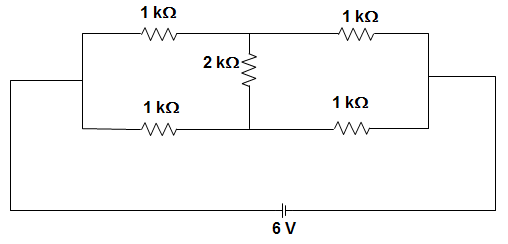
a) Zero
b) 1 mA
c) 2 mA
d) 6 mA
Answer: a
Explanation: We know that when a Wheatstone bridge is balanced, no current will flow through the middle resistance.
Here, R1R2=R3R4
Since, R1 = R2 = R3 = R4 = 1 kΩ.
4. How many incandescent lamps connected in series would consume the same total power as a single 100 W/220 V incandescent lamp. The rating of each lamp is 200 W/220 V?
a) Not possible
b) 4
c) 3
d) 2
Answer: d
Explanation: In series power = 1P
Now, 1P=1P1+1P2
= 1200+1200
Or, P = 2002 = 100 W.
5. Two networks are connected in series parallel connection. Then, the forward short-circuit current gain of the network is ____________
a) Product of Z-parameter matrices
b) Sum of h-parameter matrices
c) Sum of Z-parameter matrices
d) Product of h-parameter matrices
Answer: b
Explanation: The forward short circuit current gain is given by,
h21 = I2(s)I1(s), when V2 = 0
So, when the two networks are connected in series parallel combination,
[h11, h12; h21, h22] = [h’11 + h’11, h’12 + h’12; h’21 + h’21, h’22 + h’22]
So, h21 of total network will be sum of h parameter matrices.
6. The condition for a 2port network to be reciprocal is ______________
a) Z11 = Z22
b) BC – AD = -1
c) Y12 = -Y21
d) h12 = h21
Answer: b
Explanation: If the network is reciprocal, then the ratio of the response transform to the excitation transform would not vary after interchanging the position of the excitation.
7. The relation AD – BC = 1, (where A, B, C and D are the elements of a transmission matrix of a network) is valid for ___________
a) Both active and passive networks
b) Passive but not reciprocal networks
c) Active and reciprocal networks
d) Passive and reciprocal networks
Answer: d
Explanation: AD – BC = 1, is the condition for reciprocity for ABCD parameters, which shows that the relation is valid for reciprocal network. The ABCD parameters are obtained for the network which consists of resistance, capacitance and inductance, which indicates that it is a passive network.
8. For a 2 port network, the transmission parameters are given as 10, 9, 11 and 10 corresponds to A, B, C and D. The correct statement among the following is?
a) Network satisfies both reciprocity and symmetry
b) Network satisfies only reciprocity
c) Network satisfies only symmetry
d) Network satisfies neither reciprocity nor symmetry
Answer: a
Explanation: Here, A = 10, B = 9, C = 11, D = 10
∴ A = D
∴ Condition for symmetry is satisfied.
Also, AD – BC = (10) (10) – (9) (11)
= 100 – 99 = 1
Therefore the condition of reciprocity is satisfied.
9. In the circuit given below, the equivalent capacitance is ______________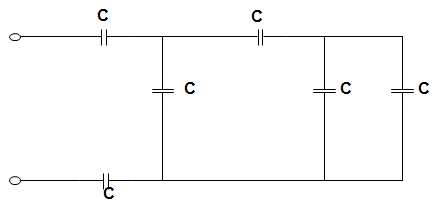
a) C4
b) 5C13
c) 5C2
d) 3C
Answer: b
Explanation: The equivalent capacitance by applying the concept of series-parallel combination of the capacitance is,
1CEQ=1C+1C+15C/3
= 1C+1C+35C=1C(5+5+35)
Or, CEQ = 5C13
123 c Energy delivered during talk time
E = ∫ V(t)I(t) dt
Given, I (t) = 2 A = constant = 2 ∫ V(t)dt
= 2 × Shaded area
= 2 × 12 × (10 + 12) × 60 × 10
= 13.2 kJ.
10. In the circuit given below, the 60 V source absorbs power. Then the value of the current source is ____________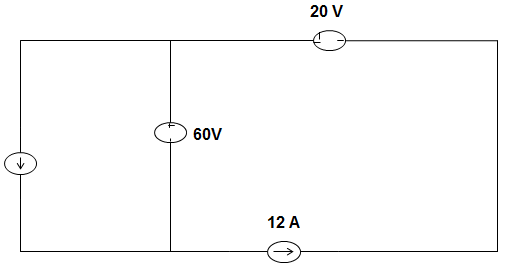
a) 10 A
b) 13 A
c) 15 A
d) 18 A
Answer: a
Explanation: Given that, 60 V source is absorbing power, it means that current flow from positive to negative terminal in 60 V source.
Applying KVL, we get, I + I1 = 12 A ……………… (1)
Current source must have the value of less than 12 A to satisfy equation (1).
11. In the circuit given below, the number of node and branches are ______________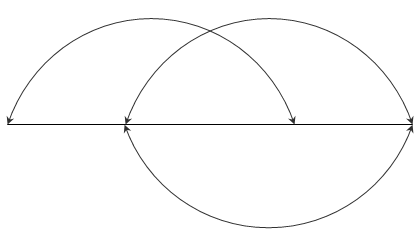
a) 4 and 5
b) 4 and 6
c) 5 and 6
d) 6 and 4
Answer: b
Explanation: In the given graph, there are 4 nodes and 6 branches.
Twig = n – 1 = 4 – 1 = 3
Link = b – n + 1 = 6 – 4 + 1 = 3.
12. A moving coil of a meter has 250 turns and a length and depth of 40 mm and 30 mm respectively. It is positioned in a uniform radial flux density of 450 mT. The coil carries a current of 160 mA. The torque on the coil is?
a) 0.0216 N-m
b) 0.0456 N-m
c) 0.1448 N-m
d) 1 N-m
Answer: a
Explanation: Given, N = 250, L = 40 × 10-3, d = 30 × 10-3m, I = 160 × 10-3A, B = 450 × 10-3 T
Torque = 250 × 450 × 10-3 × 40 × 10-3 × 30 × 10-3 × 160 × 10-3
= 200 × 10-6 N-m = 0.0216 N-m.
13. In the circuit given below, the equivalent inductance is ____________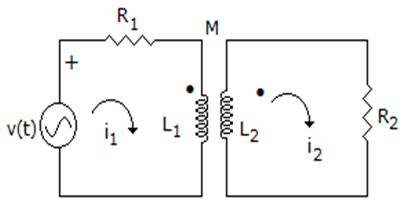
a) L1 + L2 – 2M
b) L1 + L2 + 2M
c) L1 + L2 – M
d) L1 + L2
Answer: a
Explanation: Since, in one inductor current is leaving to dot and in other inductor current is entering to dot.
So, LEQ = L1 + L2 – 2M.
14. In the figure given below, the pole-zero plot corresponds to _____________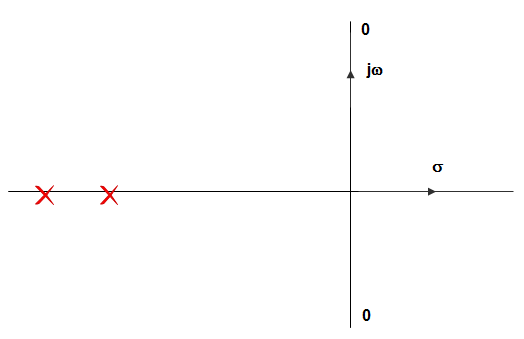
a) Low-pass filter
b) High-pass filter
c) Band-pass filter
d) Notch filter
Answer: d
Explanation: In pole zero plot the two transmission zeroes are located on the jω-axis, at the complex conjugate location, and then the magnitude response exhibits a zero transmission at ω – ωC.
15. In the circuit given below, the maximum power that can be transferred to the resistor RL is _____________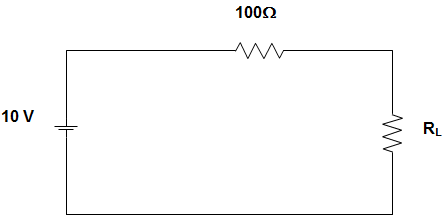
a) 1 W
b) 10 W
c) 0.25 W
d) 0.5 W
Answer: c
Explanation: For maximum power transfer to the load resistor RL, RL must be equal to 100 Ω.
∴ Maximum power = V24RL
= 1024×100 = 0.25 W.
Relation between Transmission Parameters with Short Circuit Admittance and Open Circuit Impedance Parameters
1. For a T shaped network, if the Short-circuit admittance parameters are y11, y12, y21, y22, then y11 in terms of Transmission parameters can be expressed as ________
a) y11 = DB
b) y11 = C−AB
c) y11 = – 1B
d) y11 = AB
Answer: a
Explanation: We know that, V1 = AV2 – BI2 ……… (1)
I1 = CV2 – DI2 …………… (2)
And, I1 = y11 V1 + y12 V2 ……… (3)
I2 = y21 V1 + y22 V2 ………. (4)
Now, (1) and (2) can be rewritten as, I2 = ABV2–1BV1 …………. (5)
And I1 = CV2 – D (ABV2–1BV1)=DBV1+(C−AB)V2 …………… (6)
Comparing equations (3), (4) and (5), (6), we get,
y11 = DB
y12 = C−AB
y21 = – 1B
y22 = AB.
2. For a T shaped network, if the Short-circuit admittance parameters are y11, y12, y21, y22, then y12 in terms of Transmission parameters can be expressed as ________
a) y12 = DB
b) y12 = C−AB
c) y12 = – 1B
d) y12 = AB
Answer: b
Explanation: We know that, V1 = AV2 – BI2 ……… (1)
I1 = CV2 – DI2 …………… (2)
And, I1 = y11 V1 + y12 V2 ……… (3)
I2 = y21 V1 + y22 V2 ………. (4)
Now, (1) and (2) can be rewritten as, I2 = ABV2–1BV1 …………. (5)
And I1 = CV2 – D (ABV2–1BV1)=DBV1+(C−AB)V2 …………… (6)
Comparing equations (3), (4) and (5), (6), we get,
y11 = DB
y12 = C−AB
y21 = – 1B
y22 = AB.
3. For a T shaped network, if the Short-circuit admittance parameters are y11, y12, y21, y22, then y21 in terms of Transmission parameters can be expressed as ________
a) Y21 = DB
b) Y21 = C−AB
c) Y21 = – 1B
d) Y21 = AB
Answer: c
Explanation: We know that, V1 = AV2 – BI2 ……… (1)
I1 = CV2 – DI2 …………… (2)
And, I1 = y11 V1 + y12 V2 ……… (3)
I2 = y21 V1 + y22 V2 ………. (4)
Now, (1) and (2) can be rewritten as, I2 = ABV2–1BV1 …………. (5)
And I1 = CV2 – D (ABV2–1BV1)=DBV1+(C−AB)V2 …………… (6)
Comparing equations (3), (4) and (5), (6), we get,
y11 = DB
y12 = C−AB
y21 = – 1B
y22 = AB.
4. For a T shaped network, if the Short-circuit admittance parameters are y11, y12, y21, y22, then y22 in terms of Transmission parameters can be expressed as ________
a) y22 = DB
b) y22 = C−AB
c) y22 = – 1B
d) y22 = AB
Answer: d
Explanation: We know that, V1 = AV2 – BI2 ……… (1)
I1 = CV2 – DI2 …………… (2)
And, I1 = y11 V1 + y12 V2 ……… (3)
I2 = y21 V1 + y22 V2 ………. (4)
Now, (1) and (2) can be rewritten as, I2 = ABV2–1BV1 …………. (5)
And I1 = CV2 – D (ABV2–1BV1)=DBV1+(C−AB)V2 …………… (6)
Comparing equations (3), (4) and (5), (6), we get,
y11 = DB
y12 = C−AB
y21 = – 1B
y22 = AB.
5. For a T-network if the Open circuit Impedance parameters are z11, z12, z21, z22, then z11 in terms of Transmission parameters can be expressed as ____________
a) z11 = AC
b) z11 = ADC–B
c) z11 = 1C
d) z11 = DC
Answer: a
Explanation: We know that, V1 = z11 I1 + z12 I2 …………. (1)
V2 = z21 I1 + z22 I2 ……………. (2)
And V1 = AV2 – BI2 ……… (3)
I1 = CV2 – DI2 …………… (4)
Rewriting (3) and (4), we get,
V2 = 1CI1+DCI2 …………… (5)
And V1 = A(1CI1+DCI2)–BI2=ACI1+(ADC–B)I2 ………….. (6)
Comparing (1), (2) and (5), (6), we get,
z11 = AC
z12 = ADC–B
z21 = 1C
z22 = DC.
6. For a T-network if the Open circuit Impedance parameters are z11, z12, z21, z22, then z12 in terms of Transmission parameters can be expressed as ____________
a) z12 = AC
b) z12 = ADC–B
c) z12 = 1C
d) z12 = DC
Answer: b
Explanation: We know that, V1 = z11 I1 + z12 I2 …………. (1)
V2 = z21 I1 + z22 I2 ……………. (2)
And V1 = AV2 – BI2 ……… (3)
I1 = CV2 – DI2 …………… (4)
Rewriting (3) and (4), we get,
V2 = 1CI1+DCI2 …………… (5)
And V1 = A(1CI1+DCI2)–BI2=ACI1+(ADC–B)I2 ………….. (6)
Comparing (1), (2) and (5), (6), we get,
z11 = AC
z12 = ADC–B
z21 = 1C
z22 = DC.
7. For a T-network if the Open circuit Impedance parameters are z11, z12, z21, z22, then z21 in terms of Transmission parameters can be expressed as ____________
a) z21 = AC
b) z21 = ADC–B
c) z21 = 1C
d) z21 = DC
Answer: c
Explanation: We know that, V1 = z11 I1 + z12 I2 …………. (1)
V2 = z21 I1 + z22 I2 ……………. (2)
And V1 = AV2 – BI2 ……… (3)
I1 = CV2 – DI2 …………… (4)
Rewriting (3) and (4), we get,
V2 = 1CI1+DCI2 …………… (5)
And V1 = A(1CI1+DCI2)–BI2=ACI1+(ADC–B)I2 ………….. (6)
Comparing (1), (2) and (5), (6), we get,
z11 = AC
z12 = ADC–B
z21 = 1C
z22 = DC.
8. For a T-network if the Open circuit Impedance parameters are z11, z12, z21, z22, then z22 in terms of Transmission parameters can be expressed as ____________
a) z22 = AC
b) z22 = ADC–B
c) z22 = 1C
d) z22 = DC
Answer: d
Explanation: We know that, V1 = z11 I1 + z12 I2 …………. (1)
V2 = z21 I1 + z22 I2 ……………. (2)
And V1 = AV2 – BI2 ……… (3)
I1 = CV2 – DI2 …………… (4)
Rewriting (3) and (4), we get,
V2 = 1CI1+DCI2 …………… (5)
And V1 = A(1CI1+DCI2)–BI2=ACI1+(ADC–B)I2 ………….. (6)
Comparing (1), (2) and (5), (6), we get,
z11 = AC
z12 = ADC–B
z21 = 1C
z22 = DC.
9. For a T shaped network, if the Short-circuit admittance parameters are y11, y12, y21, y22, then y11 in terms of Inverse Transmission parameters can be expressed as ________
a) y11 = A′B′
b) y11 = – 1B′
c) y11 = (C′–D′A′B′)
d) y11 = D′B′
Answer: a
Explanation: We know that, V2 = A’V1 – B’I1 ……… (1)
I2 = C’V1 – D’I1 …………… (2)
And, I1 = y11 V1 + y12 V2 ……… (3)
I2 = y21 V1 + y22 V2 ………. (4)
Now, (1) and (2) can be rewritten as, I1 = – 1B′V2+A′B′V1 …………. (5)
And I2 = C’V1 – D’ (−1B′V2+A′B′V1)=(C′–D′A′B′)V1+D′B′V2 ………… (6)
Comparing equations (3), (4) and (5), (6), we get,
y11 = A′B′
y12 = – 1B′
y21 = (C′–D′A′B′)
y22 = D′B′.
10. For a T shaped network, if the Short-circuit admittance parameters are y11, y12, y21, y22, then y12 in terms of Inverse Transmission parameters can be expressed as ________
a) y12 = A′B′
b) y12 = – 1B′
c) y12 = (C′–D′A′B′)
d) y12 = D′B′
Answer: b
Explanation: We know that, V2 = A’V1 – B’I1 ……… (1)
I2 = C’V1 – D’I1 …………… (2)
And, I1 = y11 V1 + y12 V2 ……… (3)
I2 = y21 V1 + y22 V2 ………. (4)
Now, (1) and (2) can be rewritten as, I1 = – 1B′V2+A′B′V1 …………. (5)
And I2 = C’V1 – D’ (−1B′V2+A′B′V1)=(C′–D′A′B′)V1+D′B′V2 ………… (6)
Comparing equations (3), (4) and (5), (6), we get,
y11 = A′B′
y12 = – 1B′
y21 = (C′–D′A′B′)
y22 = D′B′.
11. For a T shaped network, if the Short-circuit admittance parameters are y11, y12, y21, y22, then y21 in terms of Inverse Transmission parameters can be expressed as ________
a) y21 = A′B′
b) y21 = – 1B′
c) y21 = (C′–D′A′B′)
d) y21 = D′B′
Answer: c
Explanation: We know that, V2 = A’V1 – B’I1 ……… (1)
I2 = C’V1 – D’I1 …………… (2)
And, I1 = y11 V1 + y12 V2 ……… (3)
I2 = y21 V1 + y22 V2 ………. (4)
Now, (1) and (2) can be rewritten as, I1 = – 1B′V2+A′B′V1 …………. (5)
And I2 = C’V1 – D’ (−1B′V2+A′B′V1)=(C′–D′A′B′)V1+D′B′V2 ………… (6)
Comparing equations (3), (4) and (5), (6), we get,
y11 = A′B′
y12 = – 1B′
y21 = (C′–D′A′B′)
y22 = D′B′.
12. For a T shaped network, if the Short-circuit admittance parameters are y11, y12, y21, y22, then y22 in terms of Inverse Transmission parameters can be expressed as ________
a) y22 = A′B′
b) y22 = – 1B′
c) y22 = (C′–D′A′B′)
d) y22 = D′B′
Answer: d
Explanation: We know that, V2 = A’V1 – B’I1 ……… (1)
I2 = C’V1 – D’I1 …………… (2)
And, I1 = y11 V1 + y12 V2 ……… (3)
I2 = y21 V1 + y22 V2 ………. (4)
Now, (1) and (2) can be rewritten as, I1 = – 1B′V2+A′B′V1 …………. (5)
And I2 = C’V1 – D’ (−1B′V2+A′B′V1)=(C′–D′A′B′)V1+D′B′V2 ………… (6)
Comparing equations (3), (4) and (5), (6), we get,
y11 = A′B′
y12 = – 1B′
y21 = (C′–D′A′B′)
y22 = D′B′.
13. For a T-network if the Open circuit Impedance parameters are z11, z12, z21, z22, then z11 in terms of Transmission parameters can be expressed as ____________
a) z11 = D′C′
b) z11 = 1C′
c) z11 = (A′D′C′–B′)
d) z11 = A′C′
Answer: a
Explanation: We know that, V1 = z11 I1 + z12 I2 …………. (1)
V2 = z21 I1 + z22 I2 ……………. (2)
And V2 = A’V1 – B’I1 ……… (3)
I2 = C’V1 – D’I1 …………… (4)
Rewriting (3) and (4), we get,
V2 = A’ (D′C′I1+1C′I2)–B′I1=(A′D′C′–B′)I1+A′C′I2 ………… (5)
And V1 = D′C′I1+1C′I2 ………….. (6)
Comparing (1), (2) and (5), (6), we get,
z11 = D′C′
z12 = 1C′
z21 = (A′D′C′–B′)
z22 = A′C′.
14. For a T-network if the Open circuit Impedance parameters are z11, z12, z21, z22, then z12 in terms of Transmission parameters can be expressed as ____________
a) z12 = D′C′
b) z12 = 1C′
c) z12 = (A′D′C′–B′)
d) z12 = A′C′
Answer: b
Explanation: We know that, V1 = z11 I1 + z12 I2 …………. (1)
V2 = z21 I1 + z22 I2 ……………. (2)
And V2 = A’V1 – B’I1 ……… (3)
I2 = C’V1 – D’I1 …………… (4)
Rewriting (3) and (4), we get,
V2 = A’ (D′C′I1+1C′I2)–B′I1=(A′D′C′–B′)I1+A′C′I2 ………… (5)
And V1 = D′C′I1+1C′I2 ………….. (6)
Comparing (1), (2) and (5), (6), we get,
z11 = D′C′
z12 = 1C′
z21 = (A′D′C′–B′)
z22 = A′C′.
15. For a T-network if the Open circuit Impedance parameters are z11, z12, z21, z22, then z22 in terms of Transmission parameters can be expressed as ____________
a) z22 = D′C′
b) z22 = 1C′
c) z22 = (A′D′C′–B′)
d) z22 = A′C′
Answer: d
Explanation: We know that, V1 = z11 I1 + z12 I2 …………. (1)
V2 = z21 I1 + z22 I2 ……………. (2)
And V2 = A’V1 – B’I1 ……… (3)
I2 = C’V1 – D’I1 …………… (4)
Rewriting (3) and (4), we get,
V2 = A’ (D′C′I1+1C′I2)–B′I1=(A′D′C′–B′)I1+A′C′I2 ………… (5)
And V1 = D′C′I1+1C′I2 ………….. (6)
Comparing (1), (2) and (5), (6), we get,
z11 = D′C′
z12 = 1C′
z21 = (A′D′C′–B′)
z22 = A′C′.
Relation between Hybrid Parameters with Short Circuit Admittance and Open Circuit Impedance Parameters
1. A periodic voltage v (t) = 1 + 4 sin ωt + 2 cos ωt is applied across a 1Ω resistance. The power dissipated is ____________
a) 1 W
b) 11 W
c) 21 W
d) 24.5 W
Answer: b
Explanation: Given that, v (t) = 1 + 4 sin ωt + 2 cos ωt
So, Power is given by,
Power, P = 121+422√1+222√1
= 11 W.
2. A constant k high pass p section has a characteristic impedance of 300 Ω at f = ∞. At f = fc, the characteristic impedance will be?
a) 0
b) ∞
c) 300 Ω
d) More than 300 Ω
Answer: b
Explanation: For constant k high pass p section is given by,
Z = R1–(fdf)2√
At f = fd, denominator term is 0.
So, Z = infinite.
3. In the circuit given below, the current through R is 2 sin 8t. The value of R is ___________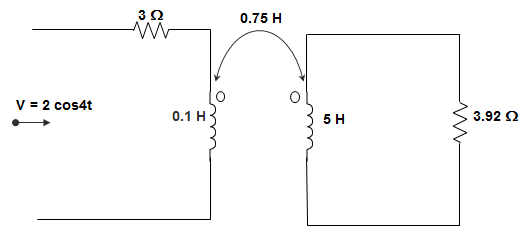
a) (0.18 + j0.72)
b) (0.46 + j1.90)
c) – (0.18 + j1.90)
d) (0.23 – 0.35 j)
Answer: d
Explanation: Here, Inductor is not given, hence ignoring the inductance. Let I1 and I2 are currents in the loop then,
I1 = 2sin8t3
= 0.66 sin 8t
Again, I2 = −jX4X0.75I13.92−2.56j
= (0.23 – 0.35j) sin 8t
So, R = (0.23 – 0.35 j).
4. For a T-network if the Short circuit admittance parameters are given as y11, y21, y12, y22, then y21 in terms of Hybrid parameters can be expressed as ________
a) y21 = (−h21h12h11+h22)
b) y21 = h21h11
c) y21 = –h12h11
d) y21 = 1h11
Answer: b
Explanation: We know that, I1 = y11 V1 + y12 V2 ……… (1)
I2 = y21 V1 + y22 V2 ………. (2)
And, V1 = h11 I1 + h12 V2 ………. (3)
I2 = h21 I1 + h22 V2 ……….. (4)
Now, (3) and (4) can be rewritten as,
I1 = V1h11–h12V2h11 ………. (5)
And I2 = h21V1h11+(−h21h12h11+h22)V2 ………. (6)
∴ Comparing (1), (2) and (5), (6), we get,
y11 = 1h11
y12 = –h12h11
y21 = h21h11
y22 = (−h21h12h11+h22).
5. For a T-network if the Open circuit impedance parameters are given as z11, z21, z12, z22, then z21 in terms of Hybrid parameters can be expressed as ________
a) z21 = (h11–h21h12h22)
b) z21 = – h21h22
c) z21 = h12h22
d) z21 = 1h22
Answer: b
Explanation: We know that, V1 = z11 I1 + z12 I2 ……… (1)
V2 = z21 I1 + z22 I2 ………. (2)
And, V1 = h11 I1 + h12 V2 ………. (3)
I2 = h21 I1 + h22 V2 ……….. (4)
Now, (3) and (4) can be rewritten as,
V1 = (h11–h21h12h22)I1+h12h22I2 ………… (5)
And V2 = I2h22–h21I1h22 ……….. (6)
∴ Comparing (1), (2) and (5), (6), we get,
z11 = (h11–h21h12h22)
z12 = h12h22
z21 = – h21h22
z22 = 1h22.
6. For a T-network if the Open circuit impedance parameters are given as z11, z21, z12, z22, then z11 in terms of Hybrid parameters can be expressed as ________
a) z11 = (h11–h21h12h22)
b) z11 = – h21h22
c) z11 = h12h22
d) z11 = 1h22
Answer: a
Explanation: We know that, V1 = z11 I1 + z12 I2 ……… (1)
V2 = z21 I1 + z22 I2 ………. (2)
And, V1 = h11 I1 + h12 V2 ………. (3)
I2 = h21 I1 + h22 V2 ……….. (4)
Now, (3) and (4) can be rewritten as,
V1 = (h11–h21h12h22)I1+h12h22I2 ………… (5)
And V2 = I2h22–h21I1h22 ……….. (6)
∴ Comparing (1), (2) and (5), (6), we get,
z11 = (h11–h21h12h22)
z12 = h12h22
z21 = – h21h22
z22 = 1h22.
7. For a T-network if the Open circuit impedance parameters are given as z11, z21, z12, z22, then z12 in terms of Hybrid parameters can be expressed as ________
a) z12 = (h11–h21h12h22)
b) z12 = – h21h22
c) z12 = h12h22
d) z12 = 1h22
Answer: c
Explanation: We know that, V1 = z11 I1 + z12 I2 ……… (1)
V2 = z21 I1 + z22 I2 ………. (2)
And, V1 = h11 I1 + h12 V2 ………. (3)
I2 = h21 I1 + h22 V2 ……….. (4)
Now, (3) and (4) can be rewritten as,
V1 = (h11–h21h12h22)I1+h12h22I2 ………… (5)
And V2 = I2h22–h21I1h22 ……….. (6)
∴ Comparing (1), (2) and (5), (6), we get,
z11 = (h11–h21h12h22)
z12 = h12h22
z21 = – h21h22
z22 = 1h22.
8. For a T-network if the Open circuit impedance parameters are given as z11, z21, z12, z22, then z22 in terms of Hybrid parameters can be expressed as ________
a) z22 = (h11–h21h12h22)
b) z22 = – h21h22
c) z22 = h12h22
d) z22 = 1h22
Answer: d
Explanation: We know that, V1 = z11 I1 + z12 I2 ……… (1)
V2 = z21 I1 + z22 I2 ………. (2)
And, V1 = h11 I1 + h12 V2 ………. (3)
I2 = h21 I1 + h22 V2 ……….. (4)
Now, (3) and (4) can be rewritten as,
V1 = (h11–h21h12h22)I1+h12h22I2 ………… (5)
And V2 = I2h22–h21I1h22 ……….. (6)
∴ Comparing (1), (2) and (5), (6), we get,
z11 = (h11–h21h12h22)
z12 = h12h22
z21 = – h21h22
z22 = 1h22.
9. Permeability is analogous to _____________
a) Conductivity
b) Resistivity
c) Retentivity
d) Coercivity
Answer: a
Explanation: We know that resistance and reluctance are given by,
R = ρLA
And Reluctance = LμA
So, Permeability is analogous to conductivity.
10. A resistance and an inductance are connected in parallel and fed from 50 Hz ac mains. Each branch takes a current of 5 A. The current supplied by source is ____________
a) 10 A
b) 7.07 A
c) 5 A
d) 0 A
Answer: b
Explanation: The current is given by,
|5 – j5| = 52+52−−−−−−√
= 50−−√=52–√ = 7.07 A.
11. A triangular Pulse of 50 V peak is applied to a capacitor of 0.1 F. The change of the capacitor and its waveform shape is ___________
a) 10 rectangular
b) 5 rectangular
c) 5 triangular
d) 10 triangular
Answer: c
Explanation: We know that,
Q = CV
Or, 0.1 X 50 = 5
And it is a triangular pulse.
12. A 10 μF capacitor is charged from a 5 volt source through a resistance of 10 kΩ. The charging current offer 35 m sec. If the initial voltage on C is – 3 V is ___________
a) 0.56 mA
b) 5.6 mA
c) 6 mA
d) 5 μA
Answer: a
Explanation: Initial current immediately after charging is given by,
VR=5+310000
= 0.8 mA
Now, i = i0e-t/RC
= 0.8 mA x et10kX10X10−6
= 0.8 X 10-3 X e35X10−310−1
= 0.56 mA.
13. For a T-network if the Open circuit impedance parameters are given as z11, z21, z12, z22, then z11 in terms of Inverse Hybrid parameters can be expressed as ________
a) z12 = 1g11
b) z12 = – g12g11
c) z12 = – g21g11
d) z12 = (g22–g21g12g11)
Answer: a
Explanation: We know that, V1 = z11 I1 + z12 I2 ……… (1)
V2 = z21 I1 + z22 I2 ………. (2)
And, I1 = g11 V1 + g12 I2 ………. (3)
V2 = g21 V1 + g22 I2 ……….. (4)
Now, (3) and (4) can be rewritten as,
V1 = I1g11–g12g11I2 ………… (5)
And V2 = (g22–g21g12g11)I2–g21I1g11 ……….. (6)
∴ Comparing (1), (2) and (5), (6), we get,
z11 = 1g11
z12 = – g12g11
z21 = – g21g11
z22 = (g22–g21g12g11).
14. For a T-network if the Open circuit impedance parameters are given as z11, z21, z12, z22, then z12 in terms of Inverse Hybrid parameters can be expressed as ________
a) z12 = 1g11
b) z12 = – g12g11
c) z12 = – g21g11
d) z12 = (g22–g21g12g11)
Answer: b
Explanation: We know that, V1 = z11 I1 + z12 I2 ……… (1)
V2 = z21 I1 + z22 I2 ………. (2)
And, I1 = g11 V1 + g12 I2 ………. (3)
V2 = g21 V1 + g22 I2 ……….. (4)
Now, (3) and (4) can be rewritten as,
V1 = I1g11–g12g11I2 ………… (5)
And V2 = (g22–g21g12g11)I2–g21I1g11 ……….. (6)
∴ Comparing (1), (2) and (5), (6), we get,
z11 = 1g11
z12 = – g12g11
z21 = – g21g11
z22 = (g22–g21g12g11).
15. For a T-network if the Open circuit impedance parameters are given as z11, z21, z12, z22, then z22 in terms of Inverse Hybrid parameters can be expressed as ________
a) z22 = 1g11
b) z22 = – g12g11
c) z22 = – g21g11
d) z22 = (g22–g21g12g11)
Answer: d
Explanation: We know that, V1 = z11 I1 + z12 I2 ……… (1)
V2 = z21 I1 + z22 I2 ………. (2)
And, I1 = g11 V1 + g12 I2 ………. (3)
V2 = g21 V1 + g22 I2 ……….. (4)
Now, (3) and (4) can be rewritten as,
V1 = I1g11–g12g11I2 ………… (5)
And V2 = (g22–g21g12g11)I2–g21I1g11 ……….. (6)
∴ Comparing (1), (2) and (5), (6), we get,
z11 = 1g11
z12 = – g12g11
z21 = – g21g11
z22 = (g22–g21g12g11).
Series-Parallel Interconnection of Two Port Network
1. If the diameter of a wire is doubled, the current carrying capacity of the wire is ___________
a) Half
b) Twice
c) Four times
d) One-fourth
Answer: c
Explanation: Since diameter is doubled, area of cross-section becomes four times. Current carrying capacity is proportional to area of cross-section.
2. Consider an RL series circuit having resistance R = 3 Ω, inductance L = 3 H and is excited by 6V. The current after a long time after closing of switch is ____________
a) 1 A
b) 2 A
c) 0 A
d) Infinity
Answer: b
Explanation: At t = ∞ the circuit has effectively two 6Ω resistances in parallel.
So, REQ = 6X66+6
= 3612 = 3 Ω
Given voltage = 6 V
So, current = 2 A.
3. The energy stored in a coil is 108 J. The power dissipated instantaneously across the blades of switch after it is opened in 10 ms is ____________
a) 108 W
b) 1080 W
c) 10800 W
d) 108000 W
Answer: c
Explanation: Power dissipated instantaneously across the blades of the switch is given by,
Power, P = EnergyTime
Given that, Energy = 108 J and time = 10 X 10-3
So, P = 10810X10−3 = 10800 W.
4. A parallel RLC circuit with R1 = 20, L1 = 1100 and C1 = 1200 is scaled giving R2 = 104, L2 = 10-4 and C2, the value of C2 is ___________
a) 0.10 nF
b) 0.3 nF
c) 0.2 nF
d) 0.4 nF
Answer: c
Explanation: K1 = R2R1
= 10420 = 5 X 102 = 500 Ω
And L1L2=kωk1
Or, kωk1=L1L2Xk1
Or, 10−210−4X5X102 = 5 X 104
Or, C2 = C1kω.k1=0.5X10−25X104X500
= 0.02 X 10-8 = 0.2 nF.
5. Barletts Bisection Theorem is applicable to ___________
a) Unsymmetrical networks
b) Symmetrical networks
c) Both unsymmetrical and symmetrical networks
d) Neither to unsymmetrical nor to symmetrical networks
Answer: b
Explanation: A symmetrical network can be split into two halves. So the z parameters of the network are symmetrical as well as reciprocal of each other. Hence Barletts Bisection Theorem is applicable to Symmetrical networks.
6. The Thevenin’s equivalent of a network is a 10 V source in series with 2 Ω resistances. If a 3 Ω resistance is connected across the Thevenin’s equivalent is _____________
a) 10 V in series with 1.2 Ω resistance
b) 6 V in series with 1.2 Ω resistance
c) 10 V in series with 5 Ω resistance
d) 6 V in series with 5 Ω resistance
Answer: b
Explanation: The Thevenin equivalent voltage is given by,
VTH = 10X35
= 6 V
And the Thevenin equivalent Resistance is given by,
RTH = 3X25 = 1.2 Ω.
7. A magnetic circuit has an iron length of 100 cm and air gap length 10 cm. If μr = 200 then which of the following is true?
a) Mmf for iron and air gap are equal
b) Mmf for iron is much less than that for air gap
c) Mmf for iron is much more than that for air gap
d) Mmf for iron and air gap are not equal
Answer: a
Explanation: We know that, MMF for air = B4πX10−7 X 10
Where B is the magnetic field intensity.
Also, MMF for iron = BX100200(4πX10−7)
= BX0.54πX10−7.
8. Two coils X and Y have self-inductances of 5 mH and 10 mH and mutual inductance of 3 mH. If the current in coils X change at a steady rate of 100 A/s, the emf induced in coil Y is ____________
a) 0.3 V
b) 0.5 V
c) 1 V
d) 1.5 V
Answer: a
Explanation: The emf is given by,
V = Mdidt
= 31000 X 100 = 0.3 V
Hence, the emf induced in coil Y is given by 0.3 V.
9. A 50 Hz current has an amplitude of 25 A. The rate of change of current at t = 0.005 after i = 0 and is increasing is ____________
a) 2221.44 A/s
b) 0
c) -2221.44 A/s
d) -3141.6 A/s
Answer: b
Explanation: The current i (t) is given by,
i = 25 sin 314.16 t and didt = 250 X 314.16 cosωt
Now, at t = 0.005, I = 25 X 314.16 cos (314.16 X 0.005)
= 0.
10. Consider a series RL circuit in which current 12 A is flowing through R and current 16 A is flowing through L. The current supplied by the sinusoidal current source I is ____________
a) 28 A
b) 4 A
c) 20 A
d) Cannot be determined
Answer: c
Explanation: Current I (t) is given by,
I (t) = 162+122−−−−−−−−√
= 256+144−−−−−−−−√
= 400−−−√
= 20 A.
11. Consider a circuit having resistances 16 Ω and 30 Ωis excited by a voltage V. A variable resistance R is connected across the 16 Ω resistance. The power dissipated in 30 Ω resistance will be maximum when value of R is __________
a) 30 Ω
b) 16 Ω
c) 9 Ω
d) 0
Answer: c
Explanation: We know that,
When R = 0, circuit current = V30 A
And Power dissipated = V230 Watts.
This is the maximum possible value which occurs for R = 0 Ω.
12. Consider a cube having resistance R on each of its sides. For this non-planar graph, the number of independent loop equations are _______________
a) 8
b) 12
c) 7
d) 5
Answer: d
Explanation: We know that the number of equations is given by,
L = B – N + 1
Where, B = Number of Branches, N = Number of Nodes
Here, B = 12 and N = 8.
So, L = 12 – 8 + 1 = 5.
13. Given two voltages, 50 ∠0 V and 75 ∠- 60° V. The sum of these voltages is ___________
a) 109 ∠- 60° V
b) 109 ∠- 25° V
c) 109 ∠- 36.6° V
d) 100 ∠- 50.1° V
Answer: c
Explanation: The voltages can be written in the form,
50 + j 0.75∠-60°
= 37.5 – j 64.95
So, sum = (50 + 37.5) – j 64.95
= 87.5 – j 64.95 = 109∠-36.6°.
14. For the circuit given below, the value of z21 parameter is ____________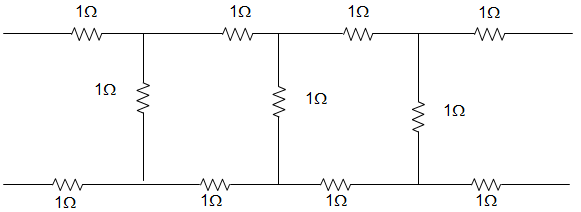
a) z21 = 0.0667 Ω
b) z21 = 2.773 Ω
c) z21 = 1.667 Ω
d) z21 = 0.999 Ω
Answer: a
Explanation: z11 = V1I1 = 2 + 1 || [2+1 || (2+1)]
z11 = 2 + 1 || (2 + 34) = 2 + 1×1141+114=2+1115 = 2.733
I0 = 11+3 I’0 = 14 I’0
And I’0 = 1 + 114 I1 = 415 I1
Or, I0 = 14×45I1=115I1
Or, V2 = I0 = 115I1
z21 = V2I1=115 = z12 = 0.0667
z22 = V2I2 = 2+1 || (2+1||3) = z11 = 2.733
∴ [z] = [2.733:0.0667; 0.0667:2.733] Ω.
15. For the circuit given below, the value of z11 parameter is ____________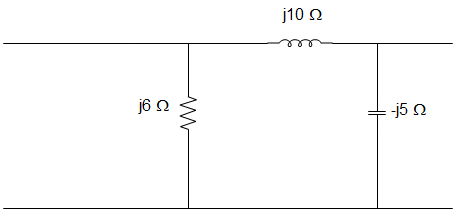
a) z11 = 1.775 + j5.739 Ω
b) z11 = 1.775 – j4.26 Ω
c) z11 = -1.775 – j4.26 Ω
d) z11 = 1.775 + j4.26 Ω
Answer: d
Explanation: z1 = 12(j10)12+j10−j5=j12012+j5
z2 = j6012+j5
z3 = 5012+j5
z12 = z21 = z2 = (−j60)(12−j5)144+25 = -1.775 – j4.26
z11 = z1 + z12 = (j120)(12−j5)144+25 + z12 = 1.775 + j4.26
z22 = z3 + z21 = (50)(12−j5)144+25 + z21 = 1.7758 – j5.739
∴ [z] = [1.775 + j4.26; -1.775 – j4.26; -1.775 – j4.26; 1.775 – j5.739] Ω.
Advanced Problems on Two Port Network – 1
1. For the circuit given below, the value of the z12 parameter is ___________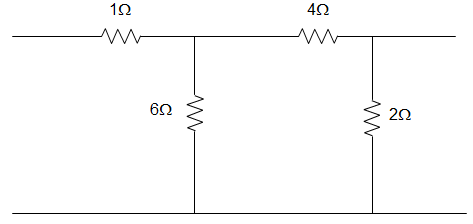
a) z12 = 1 Ω
b) z12 = 4 Ω
c) z12 = 1.667 Ω
d) z12 = 2.33 Ω
Answer: a
Explanation: z11 = V1I1 = 1 + 6 || (4+2) = 4Ω
I0 = 12I1
V2 = 2I0 = I1
z21 = V2I1 = 1Ω
z22 = V2I2 = 2 || (4+6) = 1.667Ω
So, I’0 = 22+10I2=16I2
V1 = 6I’0 = I2
z12 = V1I2 = 1Ω
Hence, [z] = [4:1; 1:1.667] Ω.
2. For the network of figure, z11 is equal to ___________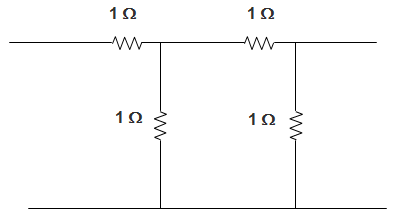
a) 53 Ω
b) 32 Ω
c) 2 Ω
d) 23 Ω
Answer: a
Explanation: From the figure, we can infer that,
Z11 = 1 + 1X23
= 1 + 23
= 53 Ω.
3. For the circuit given below, the value of z11 parameter is ____________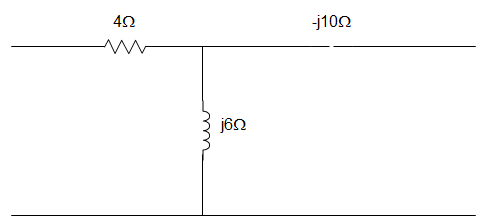
a) z11 = 4 + j6 Ω
b) z11 = j6 Ω
c) z11 = -j6 Ω
d) z11 = -j6 + 4 Ω
Answer: a
Explanation: z12 = j6 = z21
z11 – z12 = 4
Or, z11 = z12 + 4 = 4 + j6 Ω
And z22 – z12 = -j10
Or, z22 = z12 + -j10 = -j4 Ω
∴ [z] = [4+j6:j6; j6:-j4] Ω.
4. In a series RLC circuit excited by a voltage 3e-t u (t), the resistance is equal to 1 Ω and capacitance = 2 F. For the circuit, the values of I (0+) and I (∞), are ____________
a) 0 and 1.5 A
b) 1.5 A and 3 A
c) 3 A and 0
d) 3 A and 1.5 A
Answer: c
Explanation: I(s) = 6s+1–3s+0.5
Or, I(t) = 6 e-t – 3 e-0.5t
Putting, t = 0, we get, I(0) = 3A
Putting t = ∞, we get, I (∞) = 0.
5. For the circuit given below, the value of z12 parameter is ____________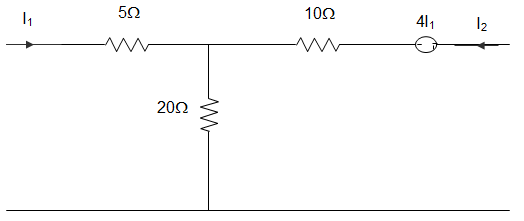
a) Z12 = 20 Ω
b) Z12 = 25 Ω
c) Z12 = 30 Ω
d) z12 = 24 Ω
Answer: a
Explanation: z11 = V1I1=(20+5)I1I1 = 25Ω
V0 = 2025V1 = 20 I1
-V0 – 4I2 + V2 = 0
Or, V2 = V0 + 4I1 = 20I1 + 4I1 = 24 I1
Or, z21 = V2I1 = 24 Ω
V2 = (10+20) I2 = 30 I2
Or, z22 = V2I1 = 30 Ω
V1 = 20I2
Or, z12 = V1I2 = 20 Ω
∴ [z] = [25:20; 24:30] Ω.
6. For the circuit given below, the value of the z22 parameter is ___________
a) z22 = 1 Ω
b) z22 = 4 Ω
c) z22 = 1.667 Ω
d) z22 = 2.33 Ω
Answer: c
Explanation: z11 = V1I1 = 1 + 6 || (4+2) = 4Ω
I0 = 12I1
V2 = 2I0 = I1
z21 = V2I1 = 1Ω
z22 = V2I2 = 2 || (4+6) = 1.667Ω
So, I’0 = 22+10I2=16I2
V1 = 6I’0 = I2
z12 = V1I2 = 1Ω
Hence, [z] = [4:1; 1:1.667] Ω.
7. For the circuit given below, the value of z22 parameter is ____________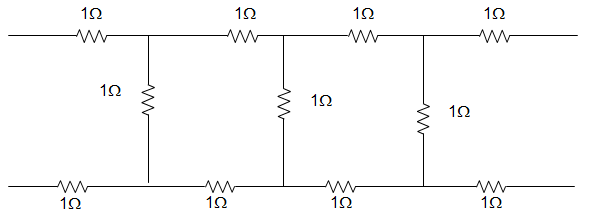
a) z22 = 0.0667 Ω
b) z22 = 2.773 Ω
c) z22 = 1.667 Ω
d) z22 = 0.999 Ω
Answer: b
Explanation: z11 = V1I1 = 2 + 1 || [2+1 || (2+1)]
z11 = 2 + 1 || (2 + 34) = 2 + 1×1141+114=2+1115 = 2.733
I0 = 11+3 I’0 = 14 I’0
And I’0 = 1 + 114 I1 = 415 I1
Or, I0 = 14×45I1=115I1
Or, V2 = I0 = 115I1
z21 = V2I1=115 = z12 = 0.0667
z22 = V2I2 = 2+1 || (2+1||3) = z11 = 2.733
∴ [z] = [2.733:0.0667; 0.0667:2.733] Ω.
8. For the circuit given below, the value of z22 parameter is ____________
a) z22 = 4 + j6 Ω
b) z22 = j6 Ω
c) z22 = -j4 Ω
d) z22 = -j6 + 4 Ω
Answer: c
Explanation: z12 = j6 = z21
z11 – z12 = 4
Or, z11 = z12 + 4 = 4 + j6 Ω
And z22 – z12 = -j10
Or, z22 = z12 + -j10 = -j4 Ω
∴ [z] = [4+j6:j6; j6:-j4] Ω.
9. For the circuit given below, the value of z22 parameter is ____________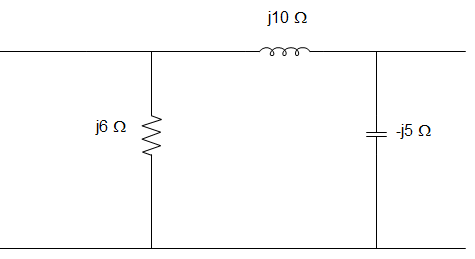
a) z22 = 1.775 + j5.739 Ω
b) z22 = 1.775 – j4.26 Ω
c) z22 = -1.775 – j5.739 Ω
d) z22 = 1.775 + j4.26 Ω
Answer: c
Explanation: z1 = 12(j10)12+j10−j5=j12012+j5
z2 = j6012+j5
z3 = 5012+j5
z12 = z21 = z2 = (−j60)(12−j5)144+25 = -1.775 – j4.26
z11 = z1 + z12 = (j120)(12−j5)144+25 + z12 = 1.775 + j4.26
z22 = z3 + z21 = (50)(12−j5)144+25 + z21 = 1.7758 – j5.739
∴ [z] = [1.775 + j4.26; -1.775 – j4.26; -1.775 – j4.26; 1.775 – j5.739] Ω.
10. For the circuit given below, the value of z22 parameter is ____________
a) z22 = 20 Ω
b) z22 = 25 Ω
c) z22 = 30 Ω
d) z22 = 24 Ω
Answer: c
Explanation: z11 = V1I1=(20+5)I1I1 = 25Ω
V0 = 2025V1 = 20 I1
-V0 – 4I2 + V2 = 0
Or, V2 = V0 + 4I1 = 20I1 + 4I1 = 24 I1
Or, z21 = V2I1 = 24 Ω
V2 = (10+20) I2 = 30 I2
Or, z22 = V2I1 = 30 Ω
V1 = 20I2
Or, z12 = V1I2 = 20 Ω
∴ [z] = [25:20; 24:30] Ω.
11. A capacitor of 220 V, 50 Hz is needed for AC supply. The peak voltage rating of the capacitor is ____________
a) 220 V
b) 460 V
c) 440 V
d) 230 V
Answer: c
Explanation: We know that,
Peak voltage rating = 2 (rms voltage rating)
Given that the RMS voltage rating = 220 V
So, the Peak Voltage Rating = 2 X 220 V
= 440 V.
12. In the circuit given below, the value of the hybrid parameter h21 is _________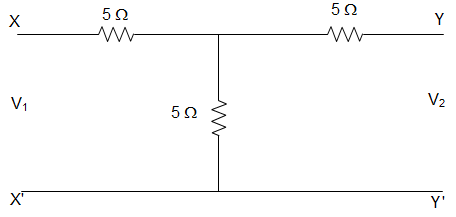
a) 10 Ω
b) 0.5 Ω
c) 5 Ω
d) 2.5 Ω
Answer: b
Explanation: Hybrid parameter h21 is given by, h21 = I2I1, when V2 = 0.
Therefore short circuiting the terminal Y-Y’, and applying Kirchhoff’s law, we get,
-5 I2 – (I2 – I1)5 = 0
Or, -I2 = I2 – I1
Or, -2I2 = -I1
∴ I2I1=12
Hence h21 = 0.5 Ω.
13. If a two port network is passive, then we have, with the usual notation, the relationship as _________
a) h21 = h12
b) h12 = -h21
c) h11 = h22
d) h11 h22 – h12 h22 = 1
Answer: d
Explanation: We know that, I1 = y11 V1 + y12 V2 ……… (1)
I2 = y21 V1 + y22 V2 ………. (2)
And, V1 = h11 I1 + h12 V2 ………. (3)
I2 = h21 I1 + h22 V2 ……….. (4)
Now, (3) and (4) can be rewritten as,
I1 = V1h11–h12V2h11 ………. (5)
And I2 = h21V1h11+(−h21h12h11+h22)V2 ………. (6)
Therefore using the above 6 equations in representing the hybrid parameters in terms of the Y parameters and applying ∆Y = 0, we get,
h11 h22 – h12 h22 = 1 [hence proved].
14. In two-port networks the parameter h22 is called _________
a) Short circuit input impedance
b) Short circuit current gain
c) Open circuit reverse voltage gain
d) Open circuit output admittance
Answer: d
Explanation: We know that, h22 = I2V2, when I1 = 0.
Since the current in the first loop is 0 when the ratio of the current and voltage in second loop is measured, therefore the parameter h12 is called as Open circuit output admittance.
15. The short-circuit admittance matrix of a two port network is as follows.
[0; -0.5; 0.5; 0] Then the 2 port network is ____________
a) Non-reciprocal and passive
b) Non-reciprocal and active
c) Reciprocal and passive
d) Reciprocal and active
Answer: b
Explanation: So, network is non reciprocal because Y12 ≠ Y21 and Y12 are also negative which means either energy storing or providing device is available. So the network is active.
Therefore the network is Non- reciprocal and active.
Advanced Problems on Two Port Network – 2
1. A network contains linear resistors and ideal voltage source S. If all the resistors are made twice their initial value, then voltage across each resistor is __________
a) Halved
b) Doubled
c) Increases by 2 times
d) Remains same
Answer: d
Explanation: The voltage/resistance ratio is a constant (say K). If K is doubled then, electric current will become half. So voltage across each resistor remains same as was initially.
2. A voltage waveform V(t) = 12t2 is applied across a 1 H inductor for t ≥ 0, with initial electric current through it being zero. The electric current through the inductor for t ≥ 0 is given by __________
a) 12 t
b) 24 t
c) 12 t3
d) 4 t3
Answer: d
Explanation: We know that, I = 1L∫t0Vdt
= 1∫t012t2dt
= 4 t3.
3. The linear circuit element among the following is ___________
a) Capacitor
b) Inductor
c) Resistor
d) Inductor & Capacitor
Answer: c
Explanation: A linear circuit element does not change their value with voltage or current. The resistance is only one among the others does not change its value with voltage or current.
4. Consider a circuit having resistance 10 kΩ, excited by voltage 5 V and an ideal switch S. If the switch is repeatedly closed for 2 ms and opened for 2 ms, the average value of i(t) is ____________
a) 0.25 mA
b) 0.35 mA
c) 0.125 mA
d) 1 mA
Answer: c
Explanation: Since i = 510×2X10−3 = 0.25 × 10-3 = 0.25 mA.
As the switch is repeatedly close, then i (t) will be a square wave.
So average value of electric current is (0.252) = 0.125 mA.
5. In the circuit given below the value of resistance Req is _____________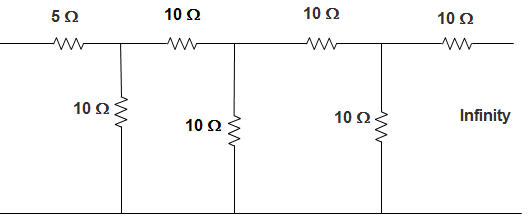
a) 10 Ω
b) 11.86 Ω
c) 11.18 Ω
d) 25 Ω
Answer: c
Explanation: The circuit is as shown in figure below.
Req = 5 + 10(Req+5)10+5+Req
Or, R2eq + 15Req = 5Req + 75 + 10Req + 50
Or, Req=125−−−√ = 11.18 Ω.
6. A particular electric current is made up of two components a 10 A, a sine wave of peak value 14.14 A. The average value of electric current is __________
a) 0
b) 24.14 A
c) 10 A
d) 14.14 A
Answer: c
Explanation: Average dc electric current = 10 A.
Average ac electric current = 0 A since it is alternating in nature.
Average electric current = 10 + 0 = 10 A.
7. Given that, R1 = 36 Ω and R2 = 75 Ω, each having tolerance of ±5% are connected in series. The value of resultant resistance is ___________
a) 111 ± 0 Ω
b) 111 ± 2.77 Ω
c) 111 ± 5.55 Ω
d) 111 ± 7.23 Ω
Answer: c
Explanation: R1 = 36 ± 5% = 36 ± 1.8 Ω
R2 = 75 ± 5% = 75 ± 3.75 Ω
∴ R1 + R2 = 111 ± 5.55 Ω.
8. Consider a circuit having a charge of 600 C, which is delivered to 100 V source in a 1 minute. The value of Voltage source V is ___________
a) 30 V
b) 60 V
c) 120 V
d) 240 V
Answer: d
Explanation: In order for 600 C charges to be delivered to 100 V source, the electric current must be in reverse clockwise direction.
Now, I = dQdt
= 60060 = 10 A
Applying KVL we get
V1 + 60 – 100 = 10 × 20 ⇒ V1 = 240 V.
9. The energy required to charge a 10 μF capacitor to 100 V is ____________
a) 0.01 J
b) 0.05 J
c) 5 X 10-9 J
d) 10 X 10-9 J
Answer: b
Explanation: E = 12 CV2
= 5 X 10-6 X 1002
= 0.05 J.
10. For the circuit given below, the value of the hybrid parameter h11 is ___________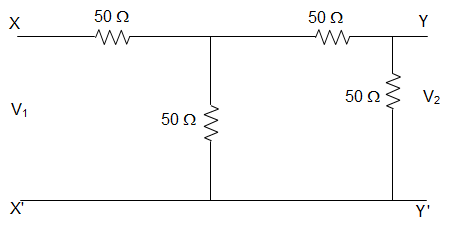
a) 75 Ω
b) 80 Ω
c) 90 Ω
d) 105 Ω
Answer: a
Explanation: Hybrid parameter h11 is given by, h11 = V1I1, when V2=0.
Therefore short circuiting the terminal Y-Y’, we get,
V1 = I1 ((50||50) + 50)
= I1 ((50×5050+50)+50)
= 75I1
∴ V1I1 = 75.
Hence h11 = 75 Ω.
11. For the circuit given below, the value of the hybrid parameter h21 is ___________
a) 0.6 Ω
b) 0.5 Ω
c) 0.3 Ω
d) 0.2 Ω
Answer: b
Explanation: Hybrid parameter h21 is given by, h21 = I2I1, when V2 = 0.
Therefore short circuiting the terminal Y-Y’, and applying Kirchhoff’s law, we get,
-50 I2 – (I2 – I1)50 = 0
Or, -I2 = I2 – I1
Or, -2I2 = -I1
∴ I2I1=12
Hence h21 = 0.5 Ω.
12. For the circuit given below, the value of the Inverse hybrid parameter g11 is ___________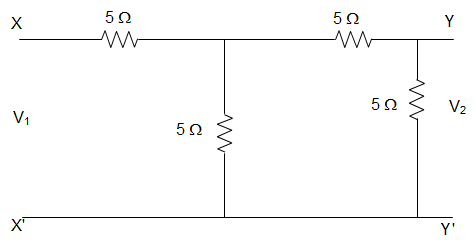
a) 0.133 Ω
b) 0.025 Ω
c) 0.3 Ω
d) 0.25 Ω
Answer: a
Explanation: Inverse Hybrid parameter g11 is given by, g11 = I1V1, when I2 = 0.
Therefore short circuiting the terminal Y-Y’, we get,
V1 = I1 ((5||5) + 5)
= I1 ((5×55+5)+5)
= 7.5I1
∴ I1V1=17.5 = 0.133 Ω
Hence g11 = 0.133 Ω.
13. A resistor of 10 kΩ with the tolerance of 5% is connected in series with 5 kΩ resistors of 10% tolerance. What is the tolerance limit for a series network?
a) 9%
b) 12.04%
c) 8.67%
d) 6.67%
Answer: d
Explanation: Error in 10 kΩ resistance = 10 × 5100 = 0.5 kΩ
Error in 5 kΩ resistance = 5 × 10100 = 5 kΩ
Total measurement resistance = 10 + 0.5 + 5 + 0.5 = 16 kΩ
Original resistance = 10 + 5 = 15 kΩ
Error = 16−1515 × 100 = 115 × 100 = 6.67%.
14. A 200 μA ammeter has an internal resistance of 200 Ω. The range is to be extended to 500μA. The shunt required is of resistance __________
a) 20.0 Ω
b) 22.22 Ω
c) 25.0 Ω
d) 50.0 Ω
Answer: c
Explanation: Ish Rsh = Im Rm
Ish = I – Im or, IIm–1=RmRsh
Now, m = IIm
Or, m – 1 = RmRsh
∴Rsh = 25 Ω.
15. A voltmeter has a sensitivity of 1000 Ω/V reads 200 V on its 300 V scale. When connected across an unknown resistor in series with a millimeter, it reads 10 mA. The error due to the loading effect of the voltmeter is
a) 3.33%
b) 6.67%
c) 13.34%
d) 13.67%
Answer: b
Explanation: RT = VTIT
VT = 200 V, IT = 10 A
So, RT = 20 kΩ
Resistance of voltmeter,
RV = 1000 × 300 = 300 kΩ
Voltmeter is in parallel with unknown resistor,
RX = RTRVRT–RV=20×300280 = 21.43 kΩ
Percentage error = Actual−ApparentActual × 100
= 21.43−2021.43 × 100 = 6.67%.
